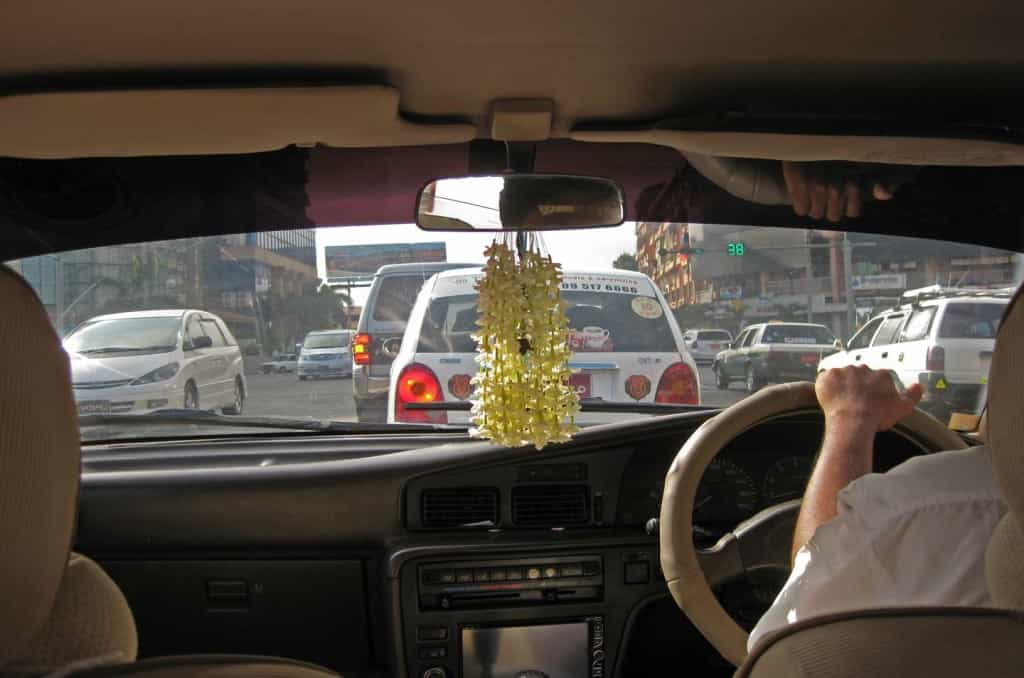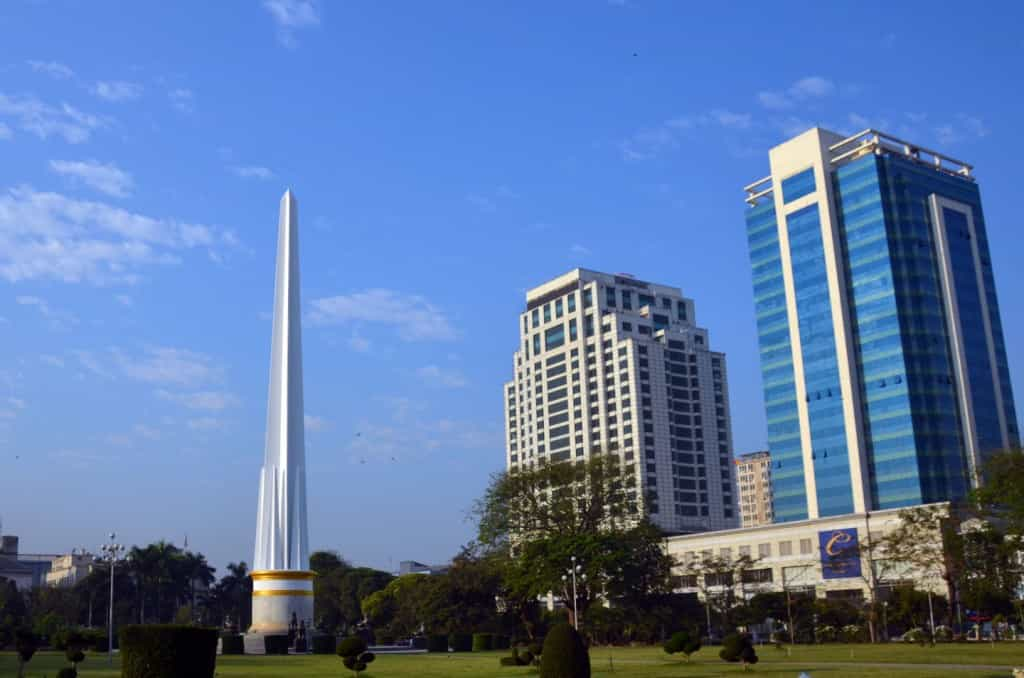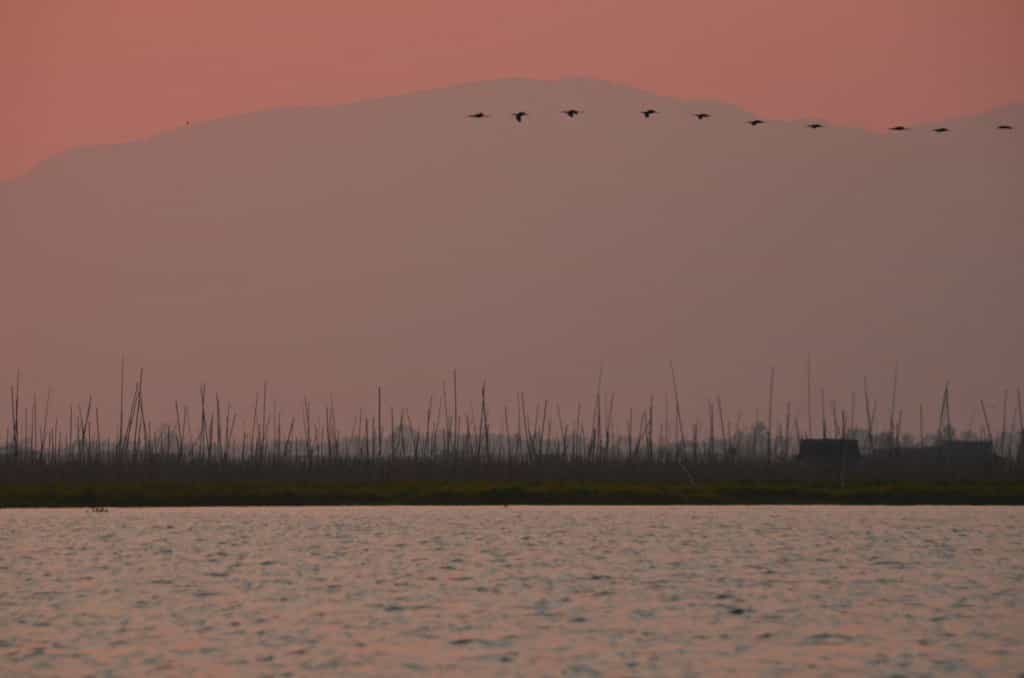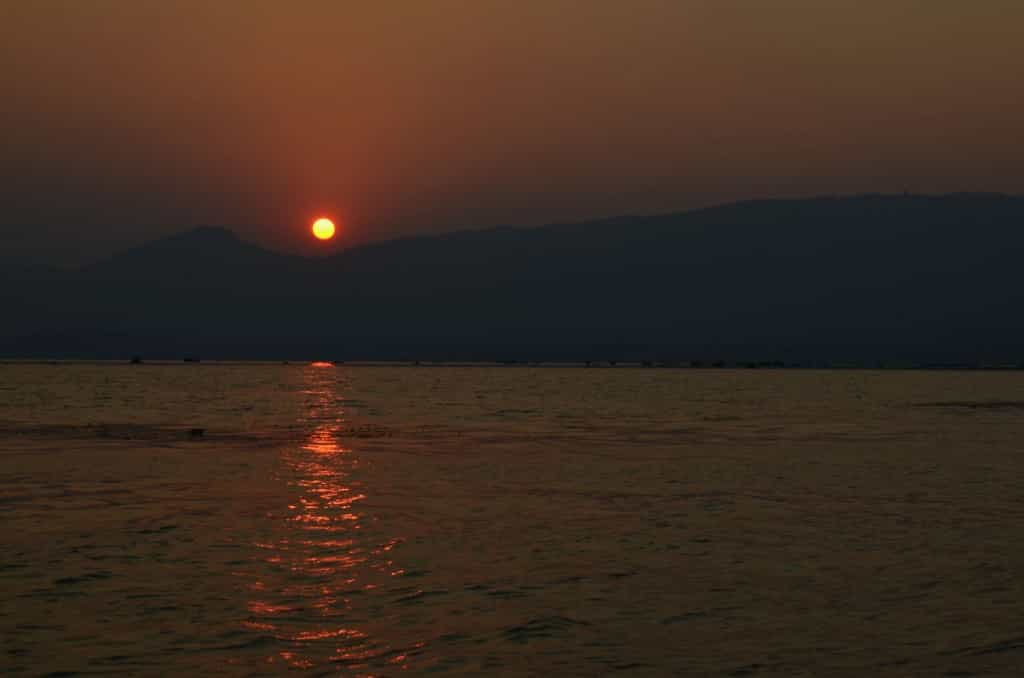I used to annoy a British colleague by telling him we drove on the right side of the road, while they drove on the wrong side. Can’t believe he bit all the time. Of course, it was a joke, but the people of Myanmar actually drive on the wrong side!
Traffic on the right, steering wheel on the right. Which means if you try to pass, your vehicle will be completely engaged in the opposite traffic lane BEFORE you can see anything. Unsurprisingly, their death rate on the road is very high. Also notice the air freshener: probably a hundred real little flowers threaded together by hand. They are sold daily by guys standing at red lights, undoubtedly for a few cents, and they smell very nice. Ah, the wonders of cheap unskilled labor.
Yangon (formerly Rangoon), is the main city of Myanmar, but lost its status of capital recently, when the authorities decided to move it to the obscure made-up city of Naypyidaw (a bit like Brasilia). It still retains the look, with all the important looking Government buildings, colonial influence and old religious sites.
Like most large cities of the area, within a few blocks, you can find the modern;
The old;
And the typical. There is a word in French, “dépaysé”, which literally means “un-countried”. It refers to the feeling of being in unfamiliar surroundings. Personally, I just love it. It can cause me to walk down the street by myself with a stupid grin on my face for an hour. The problem – for me anyways – is that it doesn’t last very long. I woke up before dawn in Mandalay and ran into a procession of a hundred monks. My reaction? Nothing! Of course there’s a hundred monks in the street, it’s 6 am. A world away from how I felt the first time I saw something like that.
Another problem is that for shock value, surprise and other odd feelings, things eventually start to look similar. If you like unfamiliar surroundings, you must visit a bustling South-East Asian market, a North-African/Middle Eastern Souk, a remote Sub-Saharan village. It will be wonderful, but it won’t necessarily be repeatable. While I’m sure a learned scholar could write tomes on the differences between Moroccan and Turkish souks, for the superficial traveller I admit to sometimes being, it’s just another souk. Plus, basically it’s about shopping, which I hate (except hardware stores; they’re wonderful). Because I like to cook, I would love to get to know a food market like the one above, but I stay in hotels, and don’t stay long enough in a country to have that experience. Maybe one day, when I’m a grown-up, I’ll do that.
So, as some of you will have figured out from my somewhat out-of-caracter tone, I went to Myanmar with a bad attitude. I felt a little blasé, and really thought I would rather be in Bhutan, Iraq or Las Vegas. But I was sure the country would have a few surprises. They came from the fashion world, in the form of face painting and National-Socialism!
Women of all ages, small children and some men with outdoor jobs, apply thanaka, a paste made from ground bark, to there faces everyday. It’s supposed to protect from the Sun and generally be good for your skin. They apply it in an infinite number of ways: just a hint, like the woman on the right, the very common two squares on the cheeks, like the girl on the left, the occasional drawings, the base coat look – like a face cream and, occasionally, you see someone working outdoors with a face cake like Bozo the Clown. In a few rare cases, in Mandalay, I saw evidently well off local women in very elegant clothes, and the little exotic face patterns made them look like they had just walked off a runway in Milan.
Nazi regalia: how do I explain it? Truth be told, it’s hardly that common, but I saw it at least 6-7 times, in different cities. Maybe the two guys in the pictures understand it as being “bad ass”, but the village woman I saw near Heho, riding a motor scooter with a replica SS helmet does not, for sure, have any concept of what it is. “General culture” doesn’t have a big place in rural South-East Asian education and if a peasant woman knows anything about World War II, it’s about the Japanese occupation. So, my big question is not why people would wear them; people will wear anything. But someone has to decide to make the stuff, so someone has to think there is a market for it (ok, t-shirt is easy, but no so much the helmets). I am at a loss for an explanation.
From Yangon, I flew to Heho where one catches an hour long taxi to the village of Nyaungshwe. The village itself is not particularly interesting, but it is known as the gateway to Inle Lake. The main activity consists in renting a large powered longboat for a tour on the lake. I met three British travellers and we booked the longest tour possible, a full 10 hours on the water. While most of the stops along the way were unremarkable, the boat trip itself was fantastic. Unlike places like Lake Titicaca (Peruvian side), where you can tell the floating villages are there for the tourist’s benefit only, Inle has a large, dynamic community of lake dwellers, called the Intha. They are known for their unique style of rowing, using their legs.
Among the Intha, when teenagers behave rudely, they are thrown in the lake and beaten with long paddles. OK, maybe not. I think they are fishing but, in other countries where I have seen people fish this way, there was another man in the water, with a net. I guess they try to knock out the fish and then pick them up? Unfortunately, our guide/captain had limited English skills. This is very common in a country where medium scale tourism is still very new.
The people build large villages, with sometimes massive, 2 or 3 storey homes on stilts. The ride is really quite magical.
The stops are less spectacular, featuring local arts and crafts, and yet more pagodas and monasteries. I caught this picture which illustrates a current major debate in the country pertaining to the renovation of religious buildings. Actually, I don’t think there is any debate in the country. International conservationists, historians and archeologists are concerned about the poor quality, non authentic work being done. The people of Myanmar are highly enthusiastic about making their pagodas look nice again and public drives for money have yielded millions of dollars (actually, billions of Kyat). An interesting debate but ultimately, it’s their pagodas, right?
About 70,000 people live on the lake. This big monastery is in one of the lake’s 4 main towns. Parked in front are a bunch of tourist – and a few local – boats. This was the view from my lunch table. I have had worse views over lunch.
Several of the recipes involved putting Catholics in the dishes. We asked what a Catholic was and got a somewhat confident sounding answer, but neither of us could understand. I think it’s the wrong translation for the name of a vegetable, but I wasn’t courageous enough that day to try a Catholic for lunch.
While I said the stops along the way were not as nice as the ride itself, the weaving shop was interesting. The amount of manual labour involved in making the smallest scarf is incredible. I joked that a scarf made that way in Norway would cost $10,000!
This woman is using a loom with a flying shuttle, which was invented in Europe in 1733. It allowed loom weaving to become a one person operation. It also led, within a few decades, to full automation. Here, nearly 300 years later, such changes have yet to arrive.
Since the 1960s, the Intha have been building these floating gardens. They work very well, but eventually they can become grounded, contributing to the erosion of the lake’s surface area.
The forest of stilts supporting the floating gardens, at dusk.
And finally, sunset on the lake. In my humble subjective opinion, Inle Lake is the most worthwhile place to visit on the Myanmar main tourist itinerary. The big problem is that tourism has started to boom in the last 18 months or so, but infrastructure has not had time to follow. In the last two years, hotel prices have increased 200-400%. Now, Myanmar in general, and Nyaungshwe in particular, has the worst quality, most expensive accommodation in South-East Asia (Singapore and Brunei prices apart). And no, you can’t just stay where the locals stay. As a foreigner, you can only stay at establishments authorized to host international tourists, and the police does enforce it. On the food side, no such restriction. So, while tourist restaurant prices have increased a lot, if you are willing to go local -as I did-, you can still get stuffed like a pig and/or drunk like a skunk for $1-2.
Finally, guides speaking English and other major languages are not available in sufficient numbers, so the good ones all work for top of the line, very expensive tour operators. If you wanted to visit frontier Myanmar, you’ve missed it (although as parts of the country forbidden to tourists open-up gradually, there will no doubt be many mini-frontiers to discover). If you want a comfortable, not too expensive visit, I would recommend waiting just a couple of years for the tourism bubble to settle down and the local hospitality industry to catch-up.
#Myanmar



















Eggs Benedict… Eggs Pope Benedict… Eggs Pope… Eggs Catholic (with meat = with ham)
Hum… maybe. I should have asked the Nazi bikers… 😉
Pingback: Nazi Chic: The Asian Fashion Craze That Just Won’t Die | News for the Blind